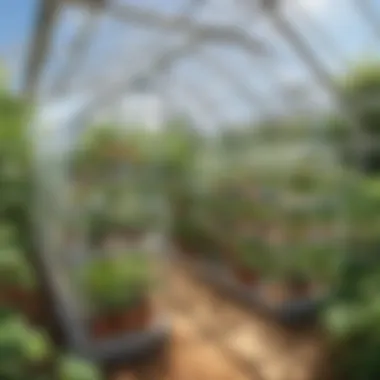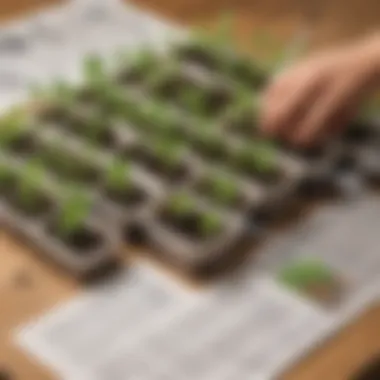Engage Young Minds with Innovative Recycling Projects for Science Enthusiasts


Science Fun Facts
Did you know that recycling one ton of paper saves 17 trees and conserves 7,000 gallons of water? Recycling not only helps reduce waste but also saves valuable resources for future generations. Understanding the impact of recycling on the environment can inspire young science enthusiasts to take action in their own lives.
Discover the Wonders of Science
By exploring various scientific concepts related to recycling, children can gain a deeper appreciation for the importance of sustainability. Educational videos and animations showcasing the recycling process can provide informative and engaging content to enhance their learning experience. Real-life applications of science in recycling can be fascinating, illustrating how everyday actions can contribute to a more sustainable future.
Science Quiz Time
Engaging in interactive quizzes and solving multiple choice questions about recycling can reinforce children's knowledge and critical thinking skills. Brain teasers and puzzles related to recycling concepts can offer a fun and challenging way to test their understanding. Learning through gamification, such as recycling-themed games, can make the educational experience more enjoyable and rewarding.
Science Experiment Showcase
Participating in fun and engaging recycling experiments can offer children hands-on experience in applying scientific principles to real-life situations. Providing step-by-step instructions and a materials list for each experiment ensures easy replication at home or in the classroom. Safety tips and precautions should always be emphasized to create a secure environment for conducting experiments and learning about recycling practices.
Introduction
Understanding the Importance of Recycling
The Concept of Recycling
Recycling involves the conversion of waste materials into reusable products to minimize the consumption of fresh resources. This process significantly reduces energy usage, air pollution, and water pollution. Through recycling, materials like paper, plastic, metal, and glass can be transformed into new items, thus cutting down on the volume of waste that ends up in landfills. By understanding the concept of recycling, children can grasp the value of resource efficiency and environmental protection.
Impact of Recycling on the Environment
The impact of recycling on the environment is profound, as it helps mitigate the depletion of natural resources and decreases greenhouse gas emissions. Recycling conserves energy, reduces landfill usage, and minimizes the need for raw material extraction. By recycling, we promote a sustainable cycle of production and consumption that leads to a healthier planet. Despite the benefits of recycling, challenges such as contamination of recyclables and inadequate infrastructure can hinder its effectiveness.
Engaging Children in Sustainable Practices


Educational Benefits of Recycling Projects
Engaging children in recycling projects offers numerous educational advantages, including fostering creativity, critical thinking, and problem-solving skills. By participating in hands-on activities like turning recyclable materials into art or science projects, children gain practical knowledge about waste reduction and resource management. These projects not only enhance academic learning but also instill a sense of responsibility towards the environment.
Encouraging Eco-Conscious Habits
Encouraging eco-conscious habits in children cultivates a mindset of sustainability and environmental stewardship. By integrating recycling practices into daily routines, children develop a sense of respect for nature and a commitment to eco-friendly behaviors. Educating children about the importance of reducing, reusing, and recycling empowers them to make conscious decisions that benefit both the planet and future generations.
Creative Recycling Project Ideas
Recycling is crucial in the quest for environmental sustainability. Creative Recycling Project Ideas not only foster innovation but also instill a sense of responsibility in young minds. These projects serve as practical examples of conservation in action, allowing children to witness the transformation of everyday items into something new and useful. By engaging in these activities, young science enthusiasts not only learn about the importance of reusing materials but also develop critical thinking skills and a deeper appreciation for the environment. Through hands-on projects like these, children are encouraged to think creatively and contribute positively to a greener world.
Paper Roll Bird Feeder
Materials Needed
Materials for the Paper Roll Bird Feeder are simple yet effective. Gather empty paper rolls, a pair of scissors, twine, birdseed, and peanut butter. The recyclable nature of paper rolls makes them an ideal choice for this project. Their cylindrical shape provides a sturdy base for the feeder, while their porous texture allows easy application of birdseed. Additionally, using peanut butter acts as a natural adhesive, ensuring that the birdseed stays in place. Despite the simplicity of the materials needed, they play a vital role in attracting and feeding birds, fostering a connection between children and nature through this project.
Step-by-Step Instructions
The step-by-step instructions for creating a Paper Roll Bird Feeder are easy to follow. Begin by cutting the paper rolls to desired lengths and punching holes at each end for the twine. Next, spread peanut butter on the surface of the roll, coating it evenly. Roll the peanut butter-coated roll in birdseed until fully covered. Finally, thread twine through the holes and tie a knot at the top for hanging. These instructions not only promote fine motor skills but also teach children the value of patience and precision in crafting items that benefit wildlife. The process of building a Paper Roll Bird Feeder serves as a tangible reminder of the impact of small actions on the ecosystem.
Plastic Bottle Terrarium
Creating a Mini Ecosystem
Constructing a Plastic Bottle Terrarium allows children to observe the intricacies of nature up close. By layering soil, small plants, and decorative elements inside a transparent plastic bottle, a mini ecosystem is created. The closed environment mimics the natural water cycle, fostering plant growth while teaching the importance of balance within ecosystems. This hands-on experience not only promotes environmental awareness but also highlights the interdependence of living organisms.
Care Tips for the Terrarium
Caring for a Plastic Bottle Terrarium involves maintaining the right balance of light, water, and airflow. Place the terrarium in indirect sunlight to prevent overheating, rotating it occasionally for even light exposure. Slightly water the soil when dry, ensuring not to overwater. Additionally, remove any wilted leaves or excess condensation to prevent mold growth. These care tips not only nurture responsibility in children but also emphasize the delicate equilibrium required to sustain a healthy terrarium ecosystem.


Cardboard Tube Marble Run
Assembling the Marble Run
Assembling a Cardboard Tube Marble Run introduces children to the basic principles of engineering and physics. By cutting and taping cardboard tubes at various angles, a functional marble run is created. The versatility of cardboard tubes allows for customizable designs, encouraging experimentation and problem-solving. Through trial and error, children learn about gravity, momentum, and friction, turning playtime into a hands-on science lesson.
Experimenting with Different Designs
Experimenting with different designs for the Marble Run sparks creativity and critical thinking. Children can modify the slope, height, and length of the tubes to observe how it impacts the marble's speed and trajectory. By introducing obstacles or twists, kids can test hypotheses and refine their designs for optimal marble movement. This experimentation not only promotes curiosity but also hones spatial reasoning skills, illustrating the importance of adaptability and innovation in problem-solving.
Tin Can Wind Chime
Decorating the Tin Cans
Decorating Tin Cans for a Wind Chime allows children to express their creativity while repurposing materials. Utilize paint, ribbons, beads, or other found objects to embellish the cans, transforming them into vibrant chimes. The act of decoration not only personalizes the wind chime but also reinforces the value of giving old items a new life. Through this artistic process, children learn to appreciate the beauty of upcycling and the significance of individual contribution to a collective piece.
Creating Soothing Melodies
Creating Soothing Melodies with a Tin Can Wind Chime combines aesthetics with auditory delight. Hang the decorated cans at varying lengths and strike them gently to produce harmonious sounds. Experiment with different arrangements to explore tone and pitch variation. The gentle tinkling of the chime not only adds an auditory dimension to the outdoor environment but also cultivates a sense of tranquility and appreciation for musical patterns. This harmonious outcome reinforces the idea that sustainable practices can harmonize with aesthetic values.
Egg Carton Seed Starter
Sowing Seeds in Egg Cartons
Sowing Seeds in Egg Cartons is a practical way to introduce children to gardening and plant life cycles. The compartments in the carton provide an organized space for planting seeds, promoting seedling growth. The biodegradable nature of the carton allows for direct planting in soil once the seedlings are ready, minimizing transplant shock. Using egg cartons as seed starters teaches children about resourcefulness and the full lifecycle of materials, from consumption to repurposing.
Caring for Seedlings
Caring for Seedlings involves providing adequate light, water, and nurturing attention. Place the egg carton in a sunny area, watering the soil lightly to keep it moist but not waterlogged. Monitor the seedlings for growth, thinning out weaker ones if necessary. Teaching children to care for seedlings nurtures patience and attentiveness, fostering a sense of responsibility for living organisms. This hands-on experience not only cultivates empathy but also empowers children to witness the rewards of their careful nurturing as seedlings grow into thriving plants.


Exploring Eco-Friendly Initiatives
In the realm of environmental conservation, exploring eco-friendly initiatives stands as a pivotal pillar of sustainable living. It encapsulates a variety of practices and projects aimed at reducing our carbon footprint and promoting a greener, healthier planet. By delving into eco-friendly initiatives, we foster a mindset of mindfulness towards our surroundings and instill values of responsibility and care for the environment. This article delves into the significance and impact of such initiatives on nurturing a generation of individuals conscious of their ecological footprint and dedicated to preserving our natural resources for posterity.
Community Recycling Drive
Organizing a collection event
When discussing the orchestration of a community recycling drive, meticulous planning and thoughtful execution are instrumental in its success. Organizing a collection event involves coordinating with local authorities or environmental organizations, setting specific collection points, and promoting active community participation. The distinctive characteristic of organizing a collection event lies in its collaborative approach, uniting community members towards a common goal of sustainable waste management. This initiative acts as a nexus where individuals can contribute actively to environmental preservation, promoting a sense of unity and shared responsibility. Despite its logistical challenges, the benefits of organizing such events are manifold, fostering community engagement, raising awareness about recycling practices, and significantly reducing landfill waste.
Donating recyclable items
A crucial aspect of any community recycling drive is the act of donating recyclable items. By encouraging individuals to partake in this noble endeavor, the drive magnifies its impact and promotes a culture of conscious consumption and waste reduction. Emphasizing the significance of donating recyclable items inspires a sense of altruism and environmental stewardship among participants, highlighting the transformative power of collective action. The unique feature of donating recyclable items lies in its ability to empower individuals to make tangible contributions to sustainability efforts and witness the direct positive outcomes of their actions. While presenting immense advantages in promoting recycling habits and resource conservation, challenges in logistics and resource allocation may present minor obstacles along the way, emphasizing the need for efficient planning and resource management.
School Recycling Program
Implementing recycling bins
Within the framework of a school recycling program, the strategic implementation ј recycling bins serves as a cornerstone in fostering a culture of sustainability and waste management within educational institutions. Placing an emphasis on separating waste and encouraging proper disposal, implementing recycling bins lays a robust foundation for instilling eco-conscious habits among students and staff. The key characteristic of this initiative lies in its simplicity yet profound impact, as the presence of dedicated recycling bins prompts individuals to make sustainable choices effortlessly. Identified as a popular choice for this article, implementing recycling bins underscores the practicality and effectiveness of integrating recycling practices seamlessly into daily routines. Despite the advantages of enhancing waste segregation and creating an eco-friendly environment, potential limitations may arise in terms of space constraints and maintenance requirements, necessitating regular monitoring and administration to ensure optimal functionality.
Educating peers about sustainability
In propagating sustainable values and practices, educating peers about sustainability emerges as a fundamental aspect of a school recycling program. By raising awareness and fostering dialogue around environmental issues, students are empowered to become advocates for positive change, influencing peer behavior and collective attitudes toward ecological conservation. The key characteristic of educating peers about sustainability lies in its transformative potential, as knowledge dissemination sparks conversations and actions that ripple throughout the school community. A beneficial and popular choice for this article, this initiative underscores the role of education in shaping eco-friendly mindsets and nurturing a culture of environmental responsibility. Despite its advantages in encouraging collective responsibility and promoting sustainable behaviors, challenges in engaging diverse audiences and ensuring long-term engagement may be encountered, necessitating innovative teaching methods and ongoing support to maintain interest and momentum.
In concluding this exploration of eco-friendly initiatives within the context of recycling projects for young Science enthusiasts, it becomes evident that these endeavors are not merely activities but profound learning experiences that lay the foundation for a future generation of environmentally-conscious global citizens. By engaging in community drives, participating in school programs, and embracing sustainability education, children embark on a journey of discovery and empowerment, equipped with the knowledge and skills to effect positive change in the world around them.
Conclusion
Inspiring a Green Revolution
Empowering the Future Generation
The vision of empowering the future generation through innovative recycling projects stems from a deep-rooted desire to cultivate sustainable practices early in life. This aspect of encouraging autonomy and environmental stewardship in children not only equips them with practical skills but also fosters a sense of ownership and responsibility for the world around them. By embracing the ethos of empowerment, young minds are empowered to initiate positive change, influencing their peers and communities towards more sustainable lifestyles. The unique feature of this approach lies in its ability to spark curiosity and ignite a passion for environmental conservation, setting the stage for a generation deeply committed to protecting the planet. While there exist challenges in implementing such initiatives, the rewards of nurturing eco-conscious leaders far outweigh the efforts involved.
Promoting Eco-Friendly Practices
Promoting eco-friendly practices serves as a cornerstone in the foundation of sustainable living, emphasizing the importance of mindful consumption and waste reduction. This facet of encouraging environmental stewardship not only benefits the individual but also ripples outwards to create a collective impact on the environment. By highlighting the significance of recycling and upcycling, these projects instill a sense of purpose and responsibility towards creating a greener future. The key characteristic of promoting eco-friendly practices lies in its ability to transform abstract concepts into tangible actions, empowering children to make a direct and measurable difference in their immediate surroundings. While challenges may arise in practicing sustainability consistently, the advantages of instilling these habits early on are reflected in the positive environmental footprint left by the upcoming generation.







